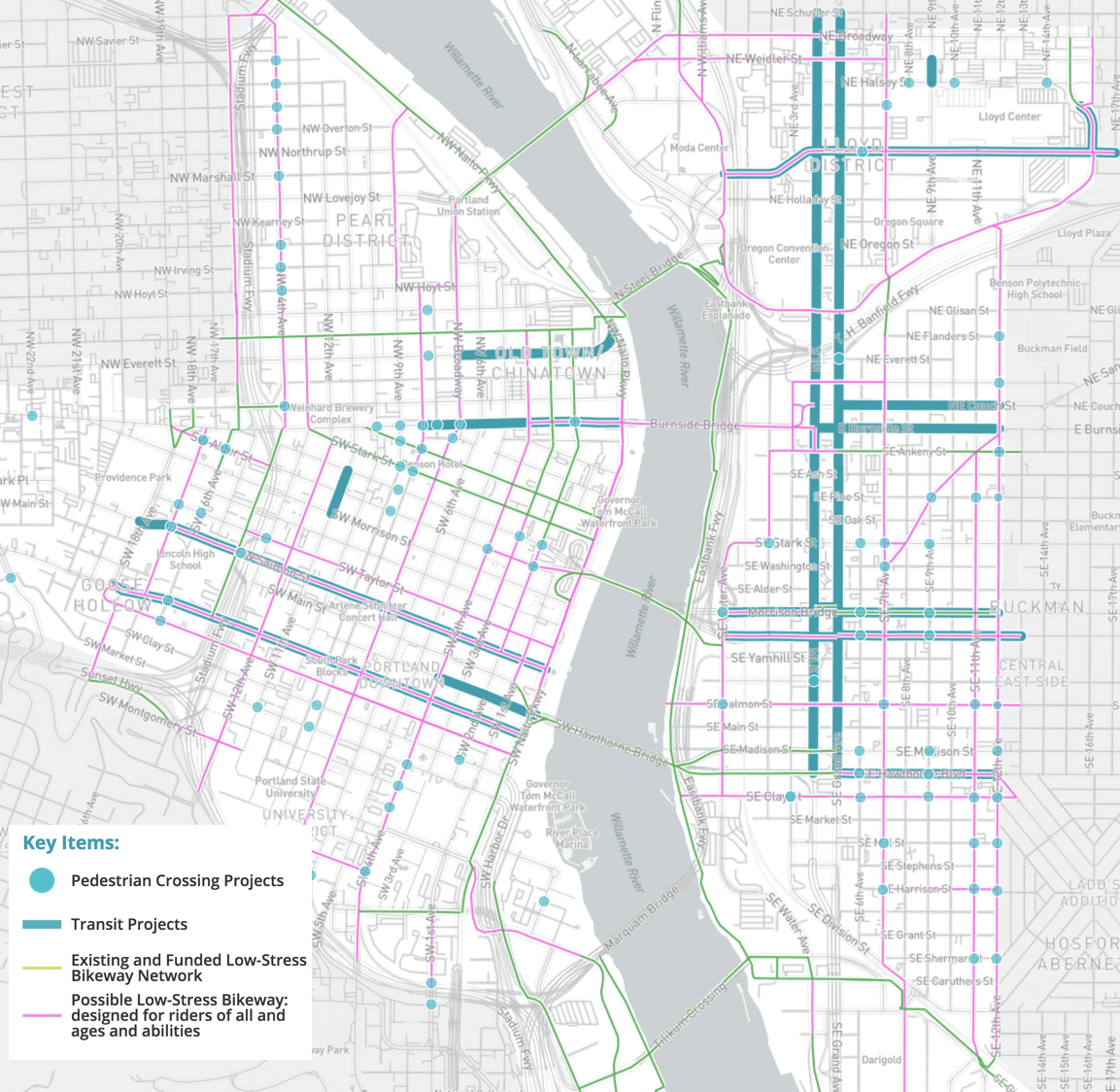
Five years of process and planning is finally starting to yield some fruit tangible fruit. We now have lines on the map and can begin to visualize a network of protected, family-friendly bikeways in the central city.
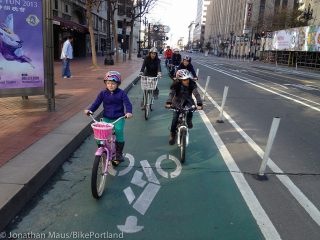
(Photos © Jonathan Maus)
Today the Portland Bureau of Transportation launches the second of a three-phase online open house for their Central City in Motion project. The website includes a “What we learned” section with key takeaways from the 1,400 comments they received since the first open house last March as well as feedback garnered from design workshops and advisory groups. The site also includes an interactive map that reveals which streets — and which designs — are likely to move forward when construction begins in 2020.
In addition to a network of safer bikeways, the project will also build safer crossings (blue circles on map) and create dedicated bus lanes to speed up transit (thick blue lines on map).
PBOT has a total (so far) of $30 million set aside for this project: $6 million from a federal grant, about $3 million in local gas tax revenue, and $20 million from System Development Charges.
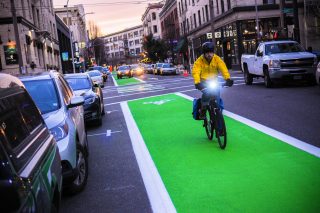
For each project shown on the interactive map PBOT has supplied a cross-design concept (they say they left off exact lane widths to keep it simple, expecting many non-wonks to participate and comment). They also ask three specific questions: “How effective would this project be at moving more people around the Central City as it grows?”; “How effective would this project be at attracting new people to transit, biking and walking?” and “Do the benefits of this project outweigh the potential impacts?”
PBOT Project Manager Gabriel Graff said in a phone interview this morning that they are trying to develop “the backbone of the bikeway system” by taking a “rungs-and-ladders approach.” Graff and his team are looking for north-south and east-west couplets that will help people enter and exit downtown — with a special focus on getting as many people as possible up and onto the bridges. Our current system of streets has resulted in too much gridlock because too many people choose to drive. If PBOT gets this right, a lot more people will choose bike, walk, and take the bus which would make the road system much more efficient and pleasant for everyone.
West of the river
On the project’s northwestern edge, PBOT has selected NW 14th and 16th between Burnside and Thurman to act as the main north-south bikeway through the Pearl District. Their current design concept shows parking protected bike lanes the entire length of this couplet separated with a painted buffer and plastic delineator wants (or other material yet to be determined). South of Burnside, they’ve proposed the major north-south bike route to be Broadway (southbound) and 4th (northbound) along with Naito Parkway along the river.
Advertisement
“Given the amount of people walking on transit mall and the number of turns by transit vehicles. It just didn’t seem like we could create a better biking environment within the framework of this project.”
— Gabriel Graff, PBOT
If the Broadway project holds in its current form, we would finally have a protected bike lane from Portland State University all the to the Broadway Bridge — something PBOT has intended to do since the existing bike lane was installed as part of former Mayor Sam Adams’ “First 100 days” promise in 2009. PBOT refers to this as a “signature, protected southbound bicycle facility through downtown Portland.”
4th Avenue would be the northbound “siganture” bikeway route through downtown, giving riders a protected bike lane from I-405 to the Steel Bridge. PBOT says 4th’s bike lane would be on the left side of the street in order to avoid the high volume of right-turning drivers who leave downtown and head east to the bridges and I-5. Like many of the proposed projects, road space on 4th Ave. would be reallocated from driving or parking cars to dedicated space for cycling. For years, PBOT has maintained that downtown streets are safe to cycle in in a shared-lane environment because signals are timed for a reasonable 10-12 mph. They now realize that’s only true for a small percentage of would-be riders, and these designs reflect that new thinking.
For east-west bike routes downtown, PBOT is proposing protected bike lanes and bus priority lanes on Jefferson/Columbia and Salmon/Taylor.
One thing you won’t see on this map: PBOT has taken the transit mall on 5th and 6th, off the table. Why? “Given the amount of people walking on transit mall and the number of turns by transit vehicles,” Graff said today. “It just didn’t seem like we could create a better biking environment within the framework of this project.” On the “What we learned: Bikeway” section of the open house, PBOT writes, “Creating a low-stress bikeway on the transit mall (SW 5th and 6th Avenues) isn’t feasible due to the large numbers of pedestrians and personal and transit vehicles using the mall.”
East of the river
On the central eastside, Water, 7th, and 11th/12th would form the network. Water would get a two-way protected bike lane from Clay to NE 2nd. There are three cross-sections shown for 7th, ranging from protected bike lanes on both sides in the southern portion to a shared-lane environment near Benson High School and then back to protected bike lanes across the (future) Sullivan’s Crossing Bridge and through the Lloyd District.
On SE 11th and 12th, PBOT said the proposed design would be a “Stark and Oak-like treatment” where the bike lane would be adjacent to other lanes and there would be auto parking on both sides.
Now PBOT needs to hear your feedback to help them continue to refine their maps in advance of the third and final open house set for later this summer. At that open house we’ll see a tiered list of projects with more detailed cost estimates. The final plan is expected to be adopted by City Council in September.
Check out all the proposed projects and cross-sections — and be sure to share your feedback — here.
— Jonathan Maus: (503) 706-8804, @jonathan_maus on Twitter and jonathan@bikeportland.org
Never miss a story. Sign-up for the daily BP Headlines email.
BikePortland needs your support.




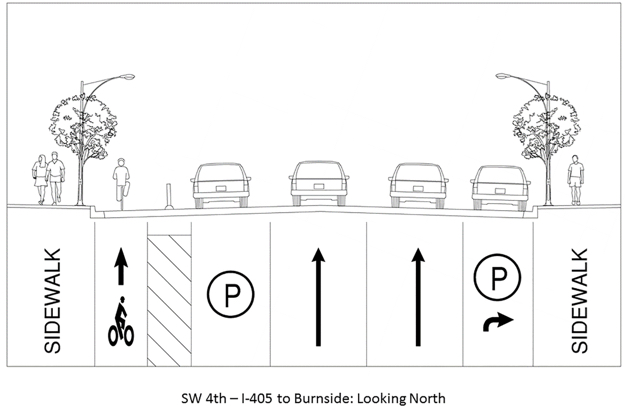
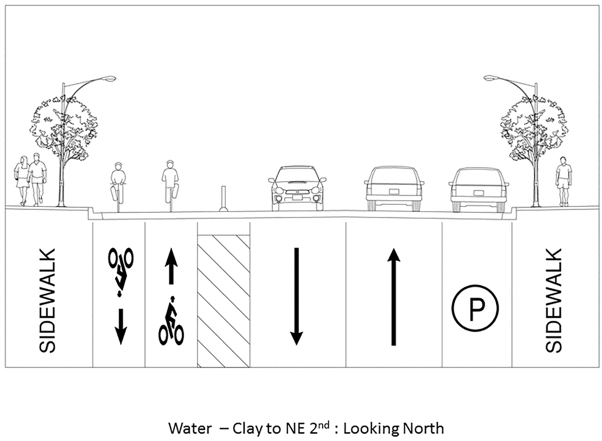
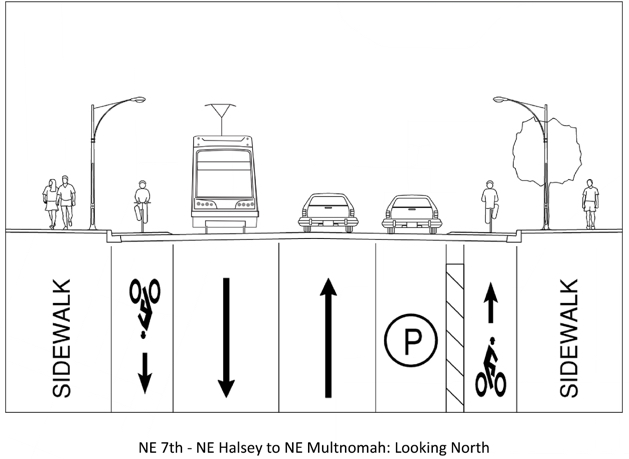


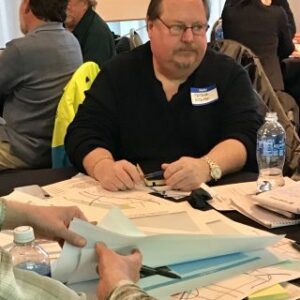

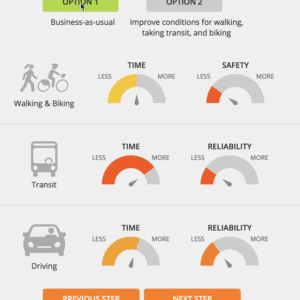
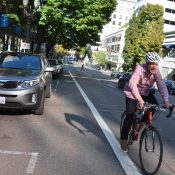
Thanks for reading.
BikePortland has served this community with independent community journalism since 2005. We rely on subscriptions from readers like you to survive. Your financial support is vital in keeping this valuable resource alive and well.
Please subscribe today to strengthen and expand our work.
I hope this plan produces the outcomes that PBOT intends. I find it really hard to see that happening though. I am continually surprised by the lack of real change, the lack of radicalism, in these plans. Perhaps that is naivety on my part, to hope for bigger changes. But I go to one of two other cities in the world, cities that have no real claim to being interested in progressive transportation, and each time a larger area of the city center is pedestrianized, is closed to non-bus traffic, has more separate dedicated bike infrastructure. And then I come back here and see plans for a dozen different ways to arrange the same old car lanes and parking spots on a street cross-section. Portland has very conservative, change-resistant transportation policies. Yes, we may be slightly better than AnyTown USA, but how does that comparison have any relevance?
Labeling streets as “low-stress” is meaningless. It is simply not true. I’ve cycled a lot on Stark/Oak over the years, there are always motor vehicles around, potentially doing unexpected/dangerous/illegal things, to be stressed about. And I’m already cycling, I’m not the demographic that PBOT needs to convince in order to meet its targets. Even the more-fully separated bike lanes are high-stress, because of intersections every 200 feet. I see this issue just about acknowledged in the PBOT presentation, but they are so far behind where they need to be (eg only now realizing that just because downtown traffic lights are timed for 10-12mph, it doesn’t mean bike riders will feel ok riding with traffic).
I don’t want to just rant and complain against policies. If PBOT had a really transformational plan, but needed a vanguard of support, there are many people desperate to work towards making those policies publicly feasible. To me it seems that PBOT has lofty goals, and tiny plans that will never reach them. I have tried to talk to officials, but get nowhere. I get official answers about targets and metrics and some wonderful far-away future, I get patronizing congratulations for being a great “advocate” for my “upcoming” neighborhood, I get ignored.
If that read like a rant to you, then sorry, rant over.
>Even the more-fully separated bike lanes are high-stress, because of intersections every 200 feet.
…which is why we need protected intersections too…
http://www.protectedintersection.com/
You are right, we do need protected intersections. I am glad that people such as yourself are looking into it. Looking at the designs in the video, I would still nevereverever trust other road users to see me, to use infrastructure as intended, or to make safe decisions.
The amount of people I see turning on red despite signs not to, turning into greenways despite signs not to, cutting me off at turns whether they see me or not, leads me to never trust a person in a motor vehicle. It is stressful, it is sad, maybe it is overprotective, but it has kept me out of collisions for these decades.
These are the kinds of experiences that need to be overcome and banished for people to feel comfortable and really push the needle on mode share. I haven’t seen a design yet that gives me confidence this will happen.
Given the limited space, limited money and limited public willingness to change behavior, it is a tough challenge.
I really liked your comment and would like to encourage you and everyone who reads it to provide that kind of feedback on the open house website. It is actually constructive: there are several places at the proposed green loop where pedestrian-only blocks would create a win-win: safer walking areas, more money flowing into local business, and great places to get people’s attention about the green loop.
I just started leaving comments — none of the bike lanes in their sketches have fully protected bike lanes, all of them show just plastic poles. I think providing feedback that more protection is needed would be very good!
It looks like the SW Jefferson/Columbia couplet does have a curb between the left side bike lane and the two traffic lanes, along with the permanent Better Naito and a one block project on NE 16th. It would be interesting to see PBOT explain why those got singled out for that treatment — maybe there’s a full roadway reconstruction project in the works for that timeframe that makes them work?
This open house is really well done. There’s lots of information, clearly presented, with the ability to comment on the individual proposals. Congrats to the team who worked on it.
I’ll be very glad to see the development of a north-south bikeway through downtown. The current set-up is less than ideal. I’m not sure plastic bollards really create “low stress” environments, but I suppose it’s a step in the right direction.
SW 4th is set to be repaved next year with money from the gas tax. That creates a real opportunity to create a great northbound protected bike lane through the heart of downtown. Hopefully without plastic wands.
The plans expressed in this open house, while better than projects in the past are still lacking overall. The degree to which PBOT is still prioritizing personal vehicle usage and storage over pedestrian and bicyclist safety and transit reliability needs to change.
Getting transit or bicycling to 15% let alone 25% is going to take more than what’s in here – they couldn’t even find a way to get personal vehicles off a single block of road in the core of the city. The Portland Art Museum is having more success getting rid of pedestrians and cyclists in the one block where they assert ownership (it’s right-of-way and a different topic but still not a completely off base comparison) than PBOT is having with cars anywhere. Repurposing lanes to accommodate the way you want people to move rather than the way they currently are is the only way to impact behavior.
It does send a message when the transit mall is taken off the table because personal vehicles are being prioritized higher than bicycles. Bus drivers (most, not all) are generally good around cyclists and their volumes are actually pretty low. It’s the personal vehicles that raise up the stress level.
Not on the central city but I rode down Rosa Parks yesterday.
If this is the future for PBOT projects we are doomed.
The biggest clusterf***k I have ever seen.
Does anyone who works there ever get on a bike?
Wide, bollard or curb-separated bike lanes, with car lanes shrunk to two – looks terrific.
On the transit mall, I would like to see the single auto lane replaced with a bike lane. Allow vehicles to use it for only limited uses (deliveries, disabled, etc).
More broadly, it feels like the stars are aligned – through years of planning, funding, and hard work by PBOT – for a real wave of bike/ped/traffic calming infrastructure projects in the coming few years. In both the central city AND in East Portland. Leah Treat’s legacy will be a proud one.
“They also ask three specific questions: “How effective would this project be at moving more people around the Central City as it grows?”; “How effective would this project be at attracting new people to transit, biking and walking?” and “Do the benefits of this project outweigh the potential impacts?”
– These three questions are really not for the average lay-person to answer. In fact, the public should be asking PBOT these questions, not the other way around. Yet, transportation professionals increasingly want the public to answer questions that can only be answered with technical expertise. It is concerning to me that PBOT doesn’t have the answers to these questions. Public involvement is valuable, but public agencies need to own the responsibility of making professional and technical judgements, to the best of their ability, for the maximum public benefit.
“Do the benefits of this project outweigh the potential impacts?”
Yes. Reducing carbon emissions, pollution, and injuries by reducing car travel is always worth it. The potential impacts of not doing so are enormous. In fact, we write policies that prioritize non-car travel for these very reasons. Maybe I’ll just quote policies from the TSP as my comments.
Remember that Mayor Wheeler could easily have installed any number of the above low (and high) stress bike lanes in his 1.5 years. Thus far he has suggested making Seasonal Naito permanent as long as it does not affect auto traffic. PBOT’s plans are worthless without leadership.
What’s the plan for getting from the Hawthorne Bridge up to SW 4th? I’ve never been a fan of riding uphill through the tangle of civic activity around the government buildings and park squares just to drop back down almost immediately.
Their plan is to jog over to Salmon. One of the 1400 comments was mine asking for a direct connection onto/off of bridges, which was repeated in the BAC meeting. I am glad to see that some routes suggested are on the map, but we still seem to be making decisions that prioritize directness for cars.
You weren’t the only one, nor was that the only ask at the BAC meeting. Decisions are being made to the detriment of bicycling for the benefit of (private) car drivers. There is nothing in this plan that significantly inconveniences car drivers. Asking cyclists to go out of their way for the benefit of modes that are lower in priority seems to be backwards.
parking protected bike lanes on SE 7th will only work safely IF PBOT insists on keeping parked cars back form the intersection. There are so many lare delivery vehicles and so many tuns on to and off of 7th that those intersections are going to need to wide open to keep it safe for bikes going straight. If they let cars park up the intersections, bikes are going to be popping out from behind those parked cars at every intersection and driveway and driveway! I really wish they would give 6th ave a greenway treatment from Division to Everett or Davis
Agreed. Parking protected lanes hide people riding bikes from people driving. More opportunities for hook collisions, “The bike came out of nowhere!”
These parking protected lanes are also very difficult to keep clean, like the horrible lane on SW 2nd that has huge puddles of standing water, leaves, debris, and drunk tourists wandering in it. With the cars parked, it is difficult or impossible to safely swerve around hazards.
Wouldn’t these complaints apply to any barrier-protected bike lane?
We need to push the city to end parking well before the intersection and to actually use the special bike lane sweeper that supposedly exists but might as well be mythical because no one has ever captured a photograph of it or found evidence of its existence (like a swept bike lane). It’s like a unicorn.
The best protected lanes are the simple bollards…
I am completely seen and in a legally protected space.
The worst are car protected lanes. I am still riding in a door zone, one I cannot escape and nobody sees me.
Just me, a car right next to me and a 6 inch curb. Trapped.
Either Greenways, bollards or paths.
We are traffic and deserve to be treated as such.
The unwillingness of the city to keep the protected lanes clear is the same, whether parking or barrier protected. The visibility issue is worse with parking-protected lanes.
NACTO recommendations call for a minimum of 30 feet.
NW 16th is not a good choice for a low stress bikeway. Most people naturally avoid it because the roar of the freeway overhead makes it hard to hear vehicles around you. It’s not just the noise. It’s… in the shadow of a smelly freeway.
In Minneapolis, a number of former left-side bike lanes have moved back to the right side, because that works better. We still have a lot of left-side bike lanes downtown, and IMO they don’t work well. I think bike lanes on the left are generally a bad idea, except as rare exceptions. Better to keep bikes on the right and handle turn conflicts with protected intersections and better light timing.
Bikes should be on the right where everyone expects them. We don’t need to engineer more surprises into our road network.
The transit portion is somewhat meaningless, unless TriMet ups its game. More frequent service, artic buses, skip stop operation, et cetera. The short little transit bypass lanes don’t do much to speed bus service. Longer bus/turn lanes shown on Burnside and MLK/Grand are a good start. To get people who won’t bike out of their cars, transit has to be significantly faster and convenient.
Hiding bikes behind parked cars is a horrible design. This is knowingly increasing the risk of intersection injuries. Why? What trade-off is worth the increased danger to riders?
…which is why we need protected intersections too…
http://www.protectedintersection.com/
That’s not the specific problem, it’s allowing parked cars anywhere close to the intersection period whether as protected bike lane or just “normally” along the curb. mid-block parking protected lanes are great. Just take away the closest parking space or two back from any corner for “daylighting” and the visibility increases massively.
https://www.streetfilms.org/hoboken-prioritizes-intersection-visibility-over-car-parking/
You also need to ensure visibility at any driveway entrances. On some blocks this is a non-issue, and on some would require all parking to be removed, leaving little “protection” in place. The other issues with being trapped (want to leave the lane to prepare to turn left or avoid debris or people or what have you? Better plan ahead!
J,
You mean the way pedestrians are now?
Is this nested correctly? I’m not following.
Are you saying that sidewalks are the same as parking-protected bike lanes? I’d argue that they have significant differences. If you’re saying that neither pedestrians nor cyclists should be hidden by vehicles parked up to the corners, or next to mid-block crosswalks, I agree with you.
…should be…where everyone expects them..
You’re prescribing conformity to the expectations of a unitary everyone that doesn’t exist. Some drivers do not expect bikes to be anywhere.
I can’t control other people, but I do know that if cyclists are hidden from view, drivers won’t expect them. Surprises take liveses. Or something.
In a few weeks when many Portlanders will inevitably be complaining about scooters on sidewalks and in the roadways let’s be sure to remind ourselves and City Council of our vast dedication of spaces toward free or heavily subsidized private dockless machine storage.